China Holds Emergency Meeting on Economy
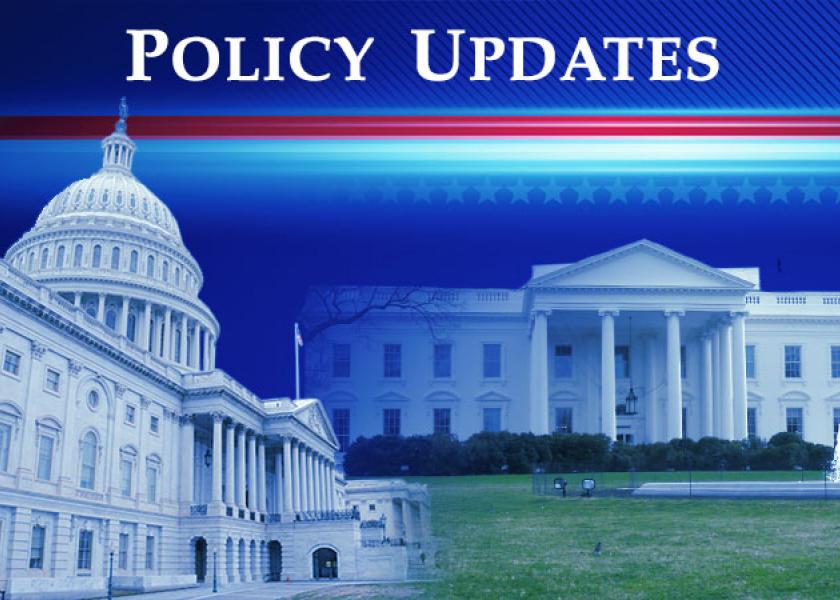
India mulls ban on rice exports | Vilsack at Senate hearing | $10,000 student debt forgiveness?
|
In Today’s Digital Newspaper |
Memorial Day trading schedule. Grain and livestock markets will trade normal hours today ahead of the extended holiday weekend. Bond markets, however, close early today at 1 pm. CT. All markets and government offices are closed for Memorial Day on Monday, May 30. Grain markets reopen at 7:00 p.m. CT on Monday for the overnight session, while livestock markets will resume trade at 8:30 a.m. CT on Tuesday, May 31. U.S. gov’t offices will be closed Monday for the holiday. AAA estimates that 39.2 million travelers will fly or drive this Memorial Day weekend ... still down from 2019's 42.8 million people who either booked flights or drove at least 50 miles to a destination, but up from last year's 36.2 million.
The Biden administration is considering sending advanced, long-range weapons systems to Ukraine, according to sources cited by CNN. The administration is leaning toward sending the systems with a larger package of military and security assistance to Ukraine, which could be announced as soon as next week.
Russian forces are making incremental progress in Ukraine’s eastern Donbas, recently capturing several villages as they attempt to surround Severodonetsk, a city in the Luhansk Oblast. Heavy Russian artillery strikes over Severodonetsk have sparked fears that it could be the next Mariupol.
The U.S. slammed Putin’s demand that sanctions on Russia must be lifted in return for him to facilitate grain and fertilizer exports, as concerns rise about global food shortages and surging prices.
Rice may be India’s next food protectionism target after it restricted wheat and sugar exports, analysts told Bloomberg, a move that could have a devastating impact on global food security as it’s an important staple.
The U.S. will bolster domestic investment and strengthen collaboration with foreign partners, Secretary of State Antony Blinken said in a speech outlining the Biden administration’s China policy.
Demand for gasoline in mid-May fell to one of its lowest levels for this time of year in nearly a decade, according to government data. The drop is an early indicator that rising gas prices are prompting some Americans to change their driving habits ahead of Memorial Day weekend and what is typically the peak summer driving season. The average price for a gallon of regular unleaded gas in the U.S. reached $4.60 on Thursday, a 51% increase from a year ago and a new all-time high. Prices rose above $4 a gallon, on average, in all 50 states last week. A report from JPMorgan this month said retail gas prices could jump to $6.20 a gallon by August.
Fertilizer prices are coming back down. "Demand destruction" and the declining cost of ammonia production have led to a sharp reversal in prices, Bloomberg reports. A North American fertilizer price index tracked by Green Markets is down 21% from its peak in late March but remains elevated compared to pre-war levels.
Some observes continue to focus on biofuels link with food needs. Håvard Halland, Rüya Perincek, and Jan Rieländer are executives at the OECD. In today’s Financial Times, they write that “links between energy and food must be weakened and that biofuels and high fertilizer prices must not lead to a hunger catastrophe.” Details below.
What will EPA announce by June 3 re: RFS as spiking gas, food costs weigh on biofuel plans, Bloomberg reports (link) that surging gas and food costs are weighing on the administration as it prepares to set mandates for the use of renewable fuels. Even under normal circumstances, the yearly biofuel quota-setting exercise is fraught, forcing presidents of both parties to navigate dueling refining and rural interests. This year, the Ukraine war and inflation are intensifying the challenges.
Climate cost formula survives for now. The White House won at least a temporary boost in its efforts to slow climate change. The U.S. Supreme Court let the Biden administration keep using its formulas for estimating the social cost of greenhouse gas emissions when regulating energy and infrastructure projects while Republican-controlled states continue to pursue litigation to block the policy in a lower court. The calculations ultimately could have a sweeping impact, affecting oil and gas leases as well as regulations covering agriculture, power plants, construction and fuel-efficiency standards.
USDA Secretary Tom Vilsack responded to many questions and topics at Thursday’s Senate Ag Committee hearing. We have details in the Policy section.
Fed Vice Chairwoman Lael Brainard told House lawmakers that a central bank digital currency could coexist with and be complementary to stablecoins.
Almost one in five (19.1%) of home sellers have lowered their price during the four-week period ended May 22, the highest rate since October 2019, suggesting homebuyers are starting to reject historically high prices, according to a report from real estate brokerage Redfin.
Carl Icahn’s proposal to add two directors to the McDonald’s board in a push for more ethical sourcing of pork received only 1% of investor votes.
Covid-19 hospitalizations in the U.S. have risen by 29% in the past two weeks, an analysis of federal data finds, and nine suspected monkeypox cases have been identified in seven states. Meanwhile, the U.S. is dramatically undercounting Covid-19 cases according to a report.
Latest White House plan would forgive $10,000 in student loans per borrower, the Washington Post reports.
|
MARKET FOCUS |
Equities today: Global stock markets were mostly firmer overnight. U.S. stock indexes are pointed toward slightly higher openings. In Asia, Japan +0.66%. Hong Kong +2.89%. China +0.23%. India +0.81%. Chinese internet stocks rallied after Alibaba and Baidu reported better-than-expected results. In Europe, at midday, London -0.10%. Paris +0.69%. Frankfurt +0.50%.
U.S. equities yesterday: The Dow rose for its fifth straight day, and the S&P and Nasdaq are poised to snap their seven-week losing streaks. The Dow ended up 516.91 points, 1.61%, at 32,637.19. The Nasdaq gained 305.91 points, 2.68%, at 11,740.65. The S&P 500 rose 79.11 points, 1.99%, at 4,057.84.
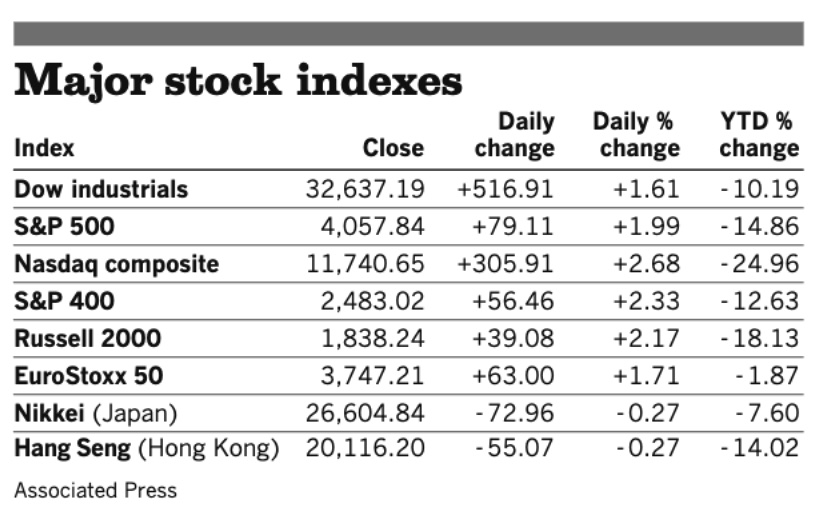
Agriculture markets yesterday:
- Corn: July corn futures fell 7 1/4 cents to $7.65, the contract’s lowest closing price since $7.58 3/4 on April 11. December corn fell 4 1/2 cents to $7.18 3/4, the lowest close in over two weeks.
- Soy complex: July soybeans surged 45 1/2 cents to $17.26 1/2, a lifetime-high close for the contract. November soybeans rose 32 cents to $15.44 3/4. July soymeal gained $4.00 to $428.20 and July soyoil rose 160 points to 80.52 cents.
- Wheat: July SRW wheat fell 5 cents to $11.43 1/4. July HRW wheat fell 4 3/4 cents to $12.28 1/2. July spring wheat futures jumped 11 3/4 cents to $12.92 1/4.
- Cotton: July cotton fell 455 points to 140.61 cents per pound, while new-crop December fell 28 points to 124.33.
- Cattle: August live cattle rose 7.5 cents to $132.60. August feeders fell $1.275 to $166.675. USDA said live steers averaged $139.82 this week through Thursday morning, down about 43 cents from last week’s average.
- Hogs: April lean hogs July lean hogs rose $3.875 to $111.825, the contract’s highest closing price since $114.60 on April 28. The CME lean hog index rose 84 cents to $103.87 (as of May 24), the sixth daily gain in a row and the highest since last August.
Ag markets today: Trading ranges were much tighter overnight than recent days in corn, soybean and wheat futures. As of 7:30 a.m. ET, corn futures were trading steady to fractionally lower, soybeans were 2 to 5 cents lower and wheat futures were mixed with prices ranging from 5 cents lower to 2 cents higher. Front-month U.S. crude oil futures were around 50 cents lower and the U.S. dollar index was holding near unchanged this morning.
Technical and other viewpoints from Jim Wyckoff: “Bullish weekly high closes in the U.S. stock indexes today would be one technical clue that near-term market bottoms are in place. Today will be an extra-important trading day for the stock indexes.”


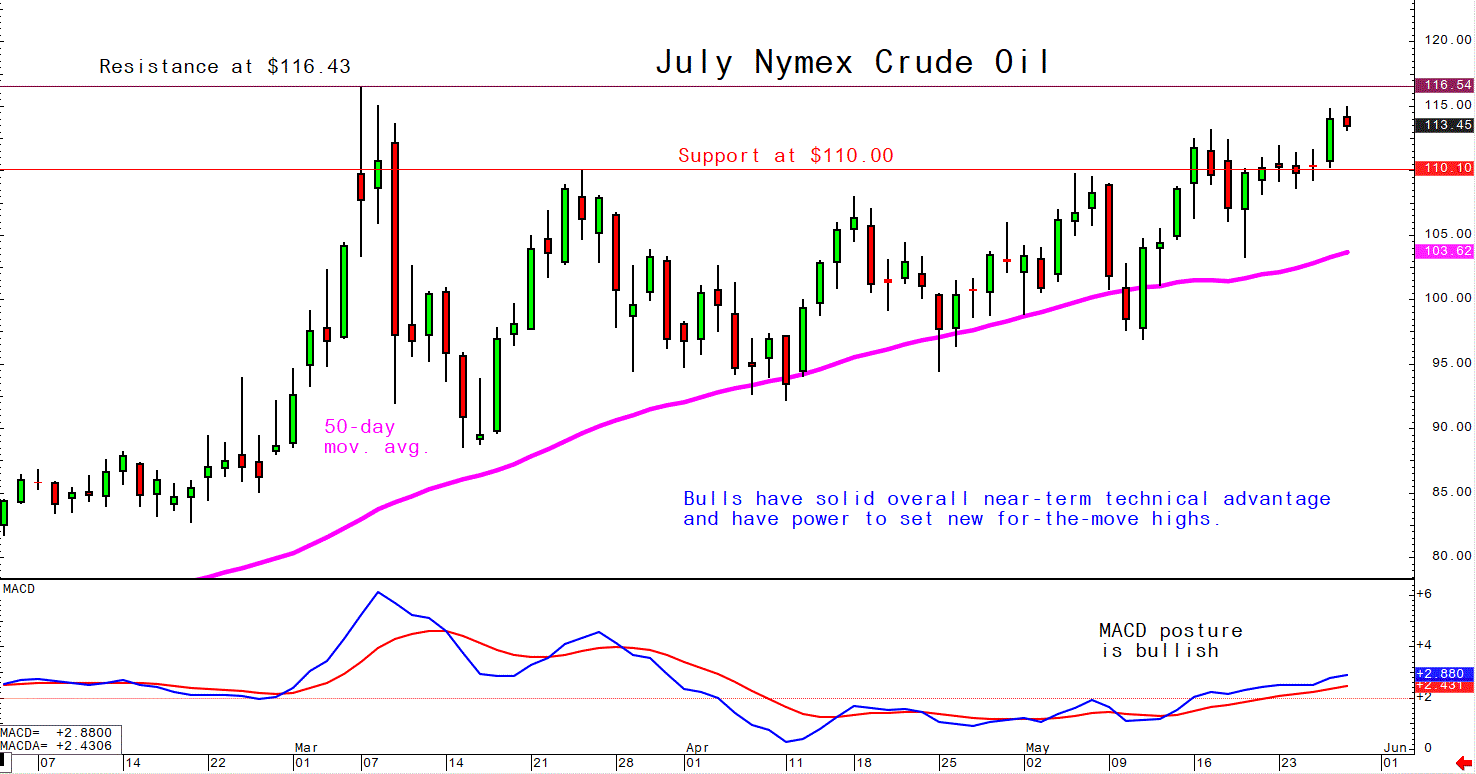


On tap today:
• U.S. consumer spending for April is expected to increase 0.7% from the prior month, and personal income is forecast to advance 0.5%. (8:30 a.m. ET)
• U.S. personal consumption expenditures price index excluding food and energy for April is expected to increase 0.3% from one month earlier and 4.9% from one year earlier. (8:30 a.m. ET)
• U.S. advance economic indicators report is out at 8:30 a.m. ET.
• University of Michigan's consumer sentiment index for May is expected to hold at 59.1, unchanged from a preliminary reading. (10 a.m. ET)
• Baker Hughes rig count is out at 1 p.m. ET.
• CFTC Commitments of Traders report, 3:30 p.m. ET.
USDA raises ag export, import forecasts. USDA now forecasts U.S. ag exports will reach a record $191.0 billion in fiscal year (FY) 2022, up $7.5 billion from the February forecast, led by corn cotton and soybeans.
USDA projects FY 2022 ag imports at a record $180.5 billion, up $8.0 billion from February, and $17.2 billion above the prior record set in FY 2021 of $163.3 billion. That would result in an ag trade surplus of $10.5 billion for FY 2022, down $500 million from the February outlook but up from $8.9 billion in FY 2021.
On ag exports, USDA noted: “Corn exports are forecast $2.2 billion higher to $19.1 billion due to record volumes and higher unit values. Overall grain and feed exports are projected $3.8 billion higher at $46.7 billion, with gains across all commodities except rice. Cotton exports are forecast at a record $9.0 billion, up $1.0 billion from the previous forecast, driven by higher unit values. Soybean exports are projected up $1.0 billion to a record $32.3 billion as higher volumes more than offset lower unit values. Total oilseed and product exports are forecast $700 million higher to a record $44.3 billion. Overall livestock, poultry, and dairy exports are projected to increase by $1.2 billion to $40.4 billion, with gains across all major commodities except pork. Beef and veal exports are projected to increase by $700 million on higher unit values as demand in East Asia is expected to remain firm.
The projection for ethanol exports is forecast at a record $3.8 billion, up $900 million from the previous forecast due mainly to higher unit values. Horticultural exports are unchanged at $38.5 billion.
Mortgage rates are starting to decline after hitting levels unseen in more than a decade. The average rate on a 30-year fixed-rate mortgage fell for the second week in a row to 5.10%, mortgage-finance giant Freddie Mac said Thursday, following their steepest rise in decades. Rates peaked at 5.3% earlier in May, the highest level since 2009 and well above the 2.94% average rate from a year earlier. Mortgage rates are falling as the red-hot housing market shows signs that it is starting to cool. Pending home sales fell 3.9% in April from March, the National Association of Realtors said Thursday, their sixth consecutive monthly decline. Meanwhile, almost one in five (19.1%) of home sellers have lowered their price during the four-week period ended May 22, the highest rate since October 2019, suggesting homebuyers are starting to reject historically high prices, according to a report from real estate brokerage Redfin.

CBO inflation forecast ‘too low,’ director says. Congressional Budget Office (CBO) Director Phillip Swagel tried to deflect criticism from Republican lawmakers over his office’s baseline budget projections for 2022, acknowledging that inflation has continued at a pace faster than CBO projected. “We know our inflation forecast is too low,” Swagel told members of the House Budget Committee yesterday. “We locked it in at the beginning of March. Subsequent events showed it was higher. We’re still going to keep the baseline economic projection constant so there’s a consistent benchmark to evaluate all proposals.” CBO projected 4% growth in the personal consumption expenditures index in fiscal 2022. Ranking member Jason Smith (R-Mo.) pressed Swagel for an estimate of how much higher inflation will be, compared to the CBO’s forecast. Swagel didn’t provide a specific answer, saying CBO had to lock its numbers in place much earlier in the Russian invasion of Ukraine. Smith said if CBO officials think its inflation projections will hold true, he has “some oceanfront property in Arizona to sell you.”
Helium shortage impacting Nebraska football. In a tradition that dates back more than 50 years, Nebraska football fans at Memorial Stadium mass-release balloons on the first Husker touchdown of a home game. But that won’t happen this fall. The university said it isn’t providing balloons to fans due to a helium shortage.

Market perspectives:
• Outside markets: The U.S. dollar index is slightly up in early trading. The yield on the 10-year U.S. Treasury note is fetching 2.75%. Nymex crude oil futures prices are weaker and trading around $113.50 a barrel.
• Fed mulls bank impact if digital dollar issued. The Federal Reserve is considering ways to blunt any impact on commercial bank deposits if the U.S. gov’t decides to issue a digital dollar, according to the central bank’s vice chair. While some decline is unavoidable, the Fed is looking at ways to avoid a significant decrease in deposits, Lael Brainard said Thursday. Industry lobbying groups including the American Bankers Association, the Bank Policy Institute and the National Association of Federally Insured Credit Unions have asked the government to hold off on launching a central bank digital currency, or CBDC, on concerns that it’d sap money from the banking system and make credit less available to businesses and households. “There’s certainly a lot of consideration that we’ve been doing in terms of thinking about potential implications for deposits,” Brainard told lawmakers on the House Financial Services Committee. “Any future evolution of the financial system with digitalization is going to lead to some diminished use of cash and some diminution of bank deposits.”
• Gasoline demand, measured on a four-week rolling average through May 20, fell to 8.8 million barrels, according to the U.S. Energy Information Administration. Excluding 2020’s steep drop in demand during pandemic lockdowns, the last time average demand for this time of year was lower was in 2013. Meanwhile, gas prices continue to rise. The average price for a gallon of regular unleaded gas in the U.S. reached $4.60 on Thursday, a 51% increase from a year ago and a new all-time high. Prices rose above $4 a gallon, on average, in all 50 states last week.
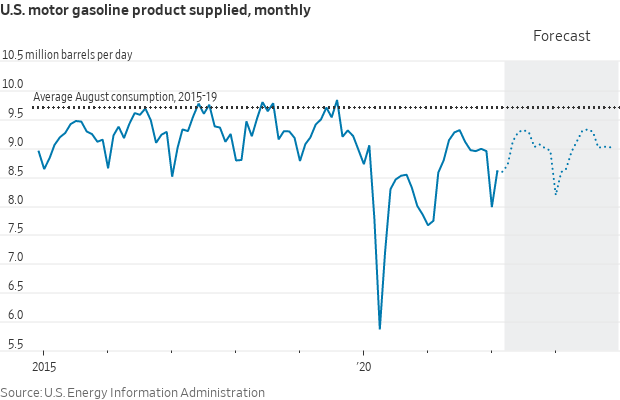
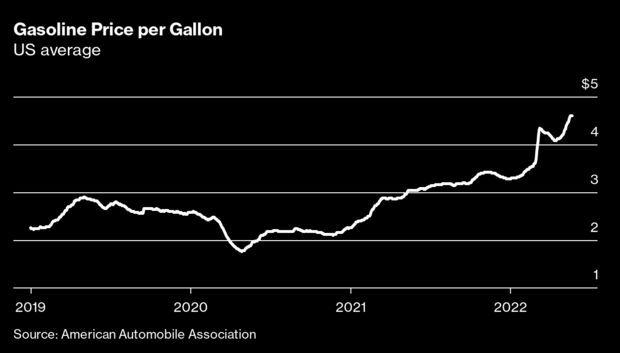
• Nitrogen prices plummet 30%, sending fertilizer makers lower. Fertilizer produces led by CF Industries fell in Thursday's trading, sending fertilizer makers lower, as nitrogen prices reportedly plunged 30%, partly due to demand destruction. According to Bloomberg, the June spot price in Tampa, Florida, for ammonia nitrogen fertilizer settled at $1,000/metric ton, a 30% drop from May's $1,425/ton. Southeast Asia and other places are seeing more buyers who are unwilling to pay the record high prices that were seen in April and May, and the cost of ammonia production has declined as European natural gas prices fell in Q2, Green Markets analyst Alexis Maxwell told Bloomberg. Link for details.
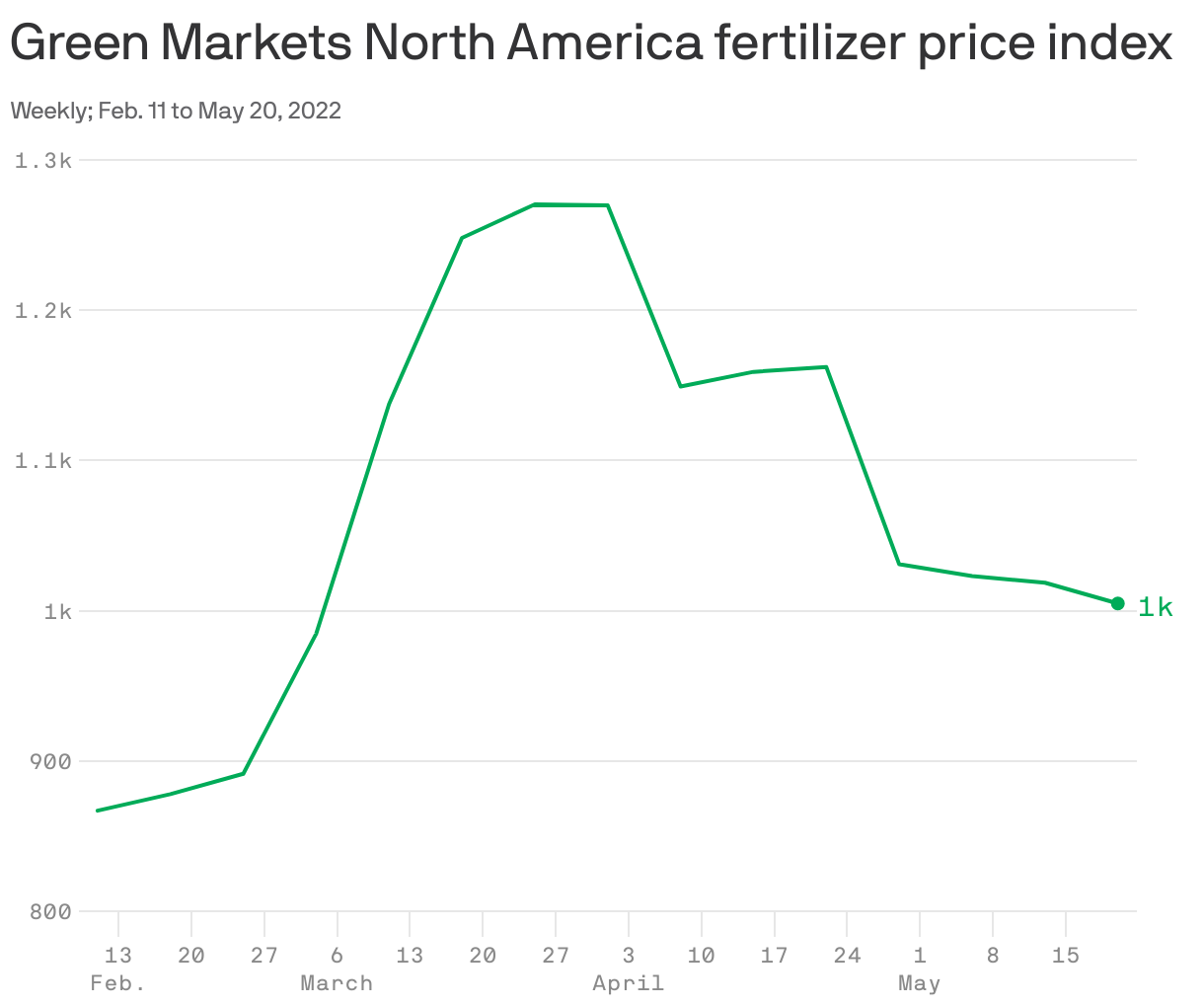
Data: Green Markets; Chart: Axios Visuals
• Rice may be India’s next food protectionism target, a move that could have a devastating impact on global food security. New Delhi’s curbs on wheat and sugar sent shock waves through world markets, and similar action on rice by the No. 1 exporter would risk causing both hunger and inflation, but higher rice prices in the U.S. Link to more via Bloomberg. The article notes that the situation of rice stocks was discussed at the meeting of an inter-ministerial committee that tracks prices of essential commodities, according to a person familiar with the matter. But the committee decided there’s no need to restrict rice shipments for now because India has huge inventories, said the person, who asked not to be identified as the information is confidential.
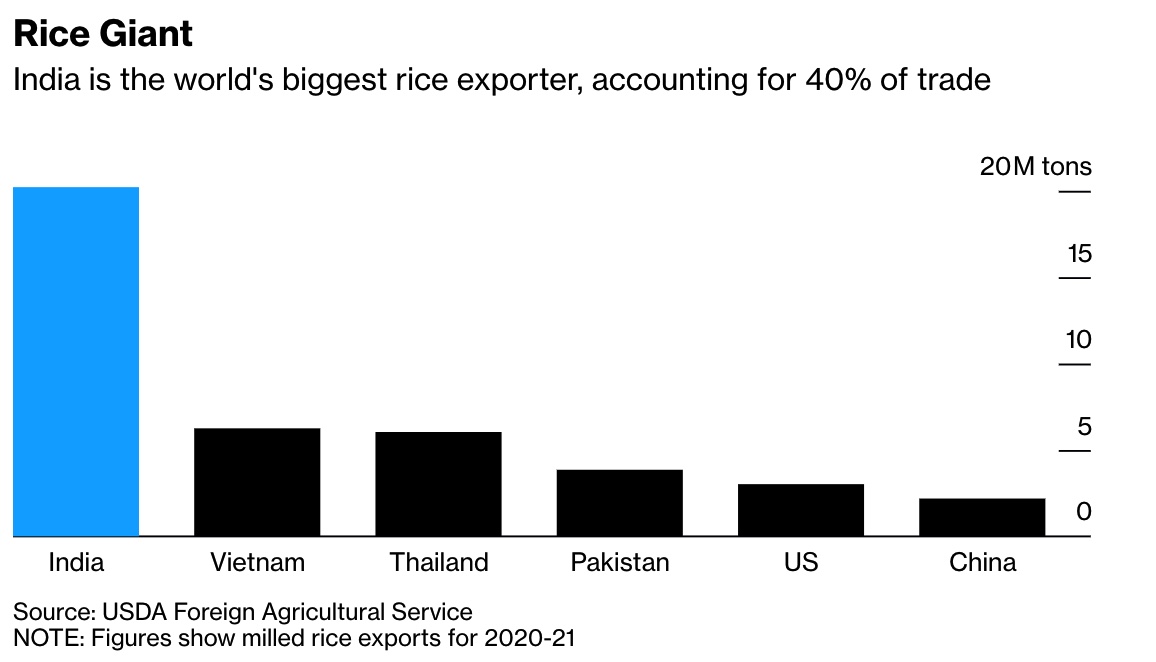
• Ag trade: South Korea purchased 124,700 MT of milling wheat, including 41,620 MT from the U.S., 50,000 MT from Australia and 33,080 MT from Canada.
• Drought in the western U.S. is expected to continue through the summer months, with reduced water supplies for some areas. The most recent Drought Monitor report depicts six percent of the total U.S. in the Exceptional Drought category, the most severe drought intensity, mostly concentrated in the West and Southwest. Although drought intensity improved in some parts of the West over the last year, most of the region is still experiencing Severe-to-Exceptional Drought. State and local emergency drought declarations have resulted in strict water conservation measures.

• Snow, severe storms and triple-digit heat are expected across the U.S. this Memorial Day weekend. More than a foot of snow will likely stick to the higher elevations above 8,000 feet in the northern Rockies. Cooler temperatures and wet conditions will impact the entire Northwest from Oregon to North Dakota. Some western coastal areas will receive wet weather first starting Saturday -- and it will slowly crawl east through the beginning of next week. On the other hand, triple-digit heat is expected to descend on Texas and other neighboring states, where temperatures will climb into the 100s, the National Weather Service said (details below).
|
• NWS weather: There will be a threat of heavy rainfall, some areas of flash flooding, and severe weather across the Mid-Atlantic and Southeast today... ...Much colder and unsettled weather is expected across the Intermountain West this weekend including the potential for higher elevation snowfall... ...Severe weather will be possible across portions of the Northern Plains... ...Critical fire weather concerns exist across much of the Southwest and through the Southern Rockies.
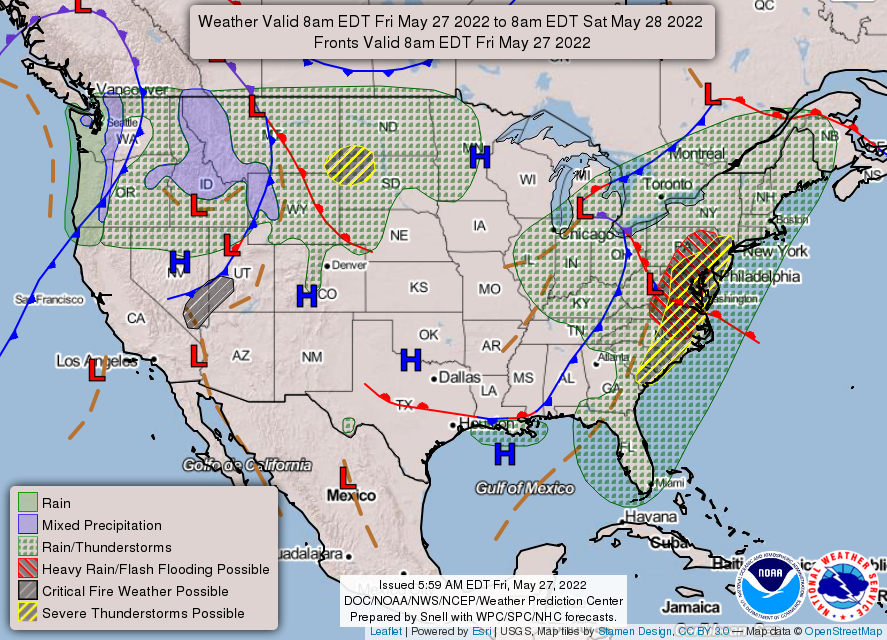

Items in Pro Farmer's First Thing Today include:
• Quiet, two-sided trade overnight
• Russia expects big jump in wheat exports (see details in Russia/Ukraine section)
• French wheat crop conditions decline for third straight week
• Russian wheat export tax jumps
• Packers slowing cattle purchases
• Hog futures extend rally, premiums to cash index
|
RUSSIA/UKRAINE |
— Summary: Russian forces encircled the cities of Severodonetsk and Lyschansk, as their attempt to fully control the Donbas region of Ukraine gathered pace. Volodymyr Zelenskyy, Ukraine’s president, accused the Kremlin of pursuing an “obvious policy of genocide.” The mayor of Severodonetsk said that 1,500 of its citizens have been killed and 60% of its residential buildings destroyed.
- British PM Boris Johnson urged further military support for Ukraine as it continues to battle Russian forces, including sending it more offensive weapons such as Multiple Launch Rocket Systems (MLRS) that can strike targets from much further away. “How can you deal with a crocodile when it’s in the middle of eating your left leg?” the British prime minister said in an interview on Friday, when asked about how the prospect of negotiating with Russian President Vladimir Putin. “The guy’s completely not to be trusted.” Ukraine has been asking nations to supply it with the MLRS as it grapples with advances by Russian troops in the far east of the country. That request has been met with some caution on whether it would bring allied nations closer to direct confrontation with Russia.
— Market impacts:
- Russia expects big jump in wheat exports. Russian wheat exports could jump to 50 MMT in 2022-23, up sharply from around 37 MMT this year, according to the country’s ag minister. Russia is expected to harvest 130 MMT of grain, including 87 MMT of wheat. Exports of grain and other commodities from Russia continue amid a lack of vessels as many owners of large ships stopped working with the market amid Western sanctions. The country’s ag ministry is in talks with the state United Shipbuilding Corp. about construction of vessels for grain exports to address the shortage.
- Russia's ruble soars. Sanctions against Russia have pushed its economy into what could be the biggest decline in decades, but the country’s currency has gone the other way. The ruble strengthened this week to levels not seen since 2018, making the currency the second-best performer against the dollar this year, based on a Dow Jones Market Data analysis of 56 currencies. The ruble has risen 16% against the greenback in 2022 and is up nearly 150% since it bottomed out days after Russia’s invasion of Ukraine three months ago. Normally, currencies follow economies up or down. In Russia’s case, government efforts that limited selling and forced buying pushed it higher, so high in fact that it has started to weigh on the economy, the WSJ reports (link). Russia has been taking steps to weaken the currency. On Thursday, Russia’s central bank lowered interest rates to 11% from 14%, making holding rubles less attractive. That sent the ruble falling 6.7% against the dollar.
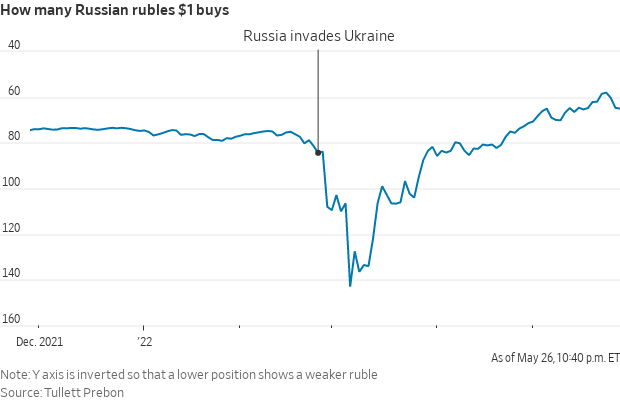
|
POLICY UPDATE |
— Key topics addressed by USDA Secretary Tom Vilsack at Thursday Senate Ag Committee hearing:
- Baby infant formula. Senate Ag Chair Debbie Stabenow (D-Mich.) noted Vilsack has “been very busy on a number of fronts, making sure WIC moms can get baby formula amid a national shortage. I appreciate how quickly, once you were notified, you went into gear. And I also want to thank Sen. Boozman and the whole committee for us working together on a bipartisan basis to — to take action.”
Vilsack said he is using the additional authority Congress provided in terms of WIC “that will allow us to work with those who produce formula in this country to create more supply.” He said USDA sent a letter to all of the state health commissioners as well as to Gerber, Nestle, and [Rickett] Mead Johnson “indicating our willingness to work with them to provide waivers so that they can continue to expand contract brand options. In terms of the WIC, state agencies allow the use of contract brand alternatives that were not previously authorized, as well as temporarily allowing them to use non-contract products to be substituted.” Vilsack said the U.S. government “will pay the rebates in — in the WIC budget itself so the companies will not be at risk financially for these substitutions. I think it will help assist in expanding access to product.”
Earlier this week, FDA Commissioner Robert Califf proposed a national stockpile of baby formula that authorities could tap to ease future shortages.
- Next farm bill field hearing in Arkansas. Sen Boozman announced Stabenow would be joining him in Arkansas next month for a second farm bill field hearing. “We'll be holding our next field hearing in Jonesboro, Arkansas on June 17. I'm excited to share the views of Arkansas's hardworking farm families with the chairwoman and my colleagues on the committee,” Boozman said.
- CRP. Boozman supported USDA’s early Thursday announcement that will allow some additional flexibilities for those with expiring CRP contracts. “But I believe that we can do more,” Boozman said. “One suggestion is look to the past. In the 2014 Farm Bill, landowners enrolled in the CRP were given an opportunity to end their contracts early without penalty. We should give serious consideration to this — penalty free incentive again until grain production returns to normal.” Boozman added that this flexibility would allow “potentially millions of acres to return to food production. The world cannot afford for prime farmland to lie fallow.” He also said in regard to EPA and USDA that there should a two-year pause on any regulatory changes to currently approved crop protection tools. “Producers need the regulatory predictability to plan for the future, and the companies that produce these inputs need the regulatory certainty to bring those tools to the market. American agriculture can meet this unprecedented moment. The federal government should ensure it's not in the way.”
Vilsack said “many, if not most” of the acres in CRP are “really not very productive” because they are “highly erodible areas and areas that are not particularly productive.” Added Vilsack: “We think that farmers can be trusted to make the right decisions.” - Crop insurance and prevent plant. Committee members John Hoeven (R-N.D.) and Amy Klobuchar, (D-Minn.) both urged Vilsack to consider offsetting penalties facing farmers who claim insurance benefits for prevented planting and then plant a crop later. Under existing rules, those farmers will get only 35% of their prevent-plant benefit. Storms “have created significant challenges for farmers who are already behind on grain planting,” Klobuchar said. Vilsack said eliminating the penalty would put crop insurers at risk. In a letter (link) to Vilsack ahead of the hearing, Hoeven, Klobuchar and other Minnesota and North Dakota lawmakers asked to offset the penalties outside of the crop insurance program “to maintain the actuarial soundness of crop insurance while shielding” crop insurance companies from risk. Vilsack said USDA “will certainly take a look at the correspondence we received yesterday and make a decision as quickly as we can.”
- Poultry competition. Vilsack said earlier on Thursday, USDA filed, to try to create more new and better markets for farmers, the beginning of a process on the Packers and Stockyards Act. “We start with the poultry tournament rule,” Vilsack explains, adding there are two components. The first is an effort to try to create greater transparency between integrators and producers, providing additional information to the producer before they enter into contracts. It's modeled after the FTC franchisee disclosure efforts, Vilsack reveals, saying it is “really designed to help producers be able to better value the costs and risks that they're taking in entering into a contract with an integrator. It allows them to manage that risk by knowing a bit more about who they're doing business with. We're requesting that they — the integrators — provide information concerning the number of placements and the stock density, a history of payments under prior tournaments so that folks can understand and appreciate where they might be in the process… A bit of information about the background of the integrator, whether they've been in bankruptcy at any point in time, whether they're involved in litigation. And the ability of producers to be able to share that information with their financial advisors and those who are providing them legal assistance, so that they're in the best possible position to understand and appreciate the risk.” Vilsack said there will be an exemption for very small live poultry dealers in this proposal. In addition, he said, USDA has provided additional disclosures concerning the inputs that a farmer is receiving, both at the time of placement and at the time of settlement. “We want the farmer to be able to understand the breed, the fact -- the facility that was breeding the stock that they're being provided, the sex, the flock age, health issues that may have cropped up. And essentially at the time of the settlement, understanding the distribution of inputs, the housing specifications, feed disruptions that may have impacted and affected the rankings.” All of this is designed, Vilsack said, “to avoid deception and to provide farmers with the ability to understand precisely what they're getting into. A 60-day comment period… we believe from our analysis that the benefits of transparency and additional disclosure exceed the costs.”
Vilsack also revealed that USDA will be filing a study that was done on competition in the retail and seed area.
- Meat processing expansion. Vilsack also noted that USDA on Thursday morning announced a $200 million effort to try to help existing meat and poultry facilities. It's an intermediary loan program. It's going to provide grants to co-ops, other nonprofit organizations, public agencies, to create revolving loan funds to assist and help those facilities to remain in business, Vilsack explains. USDA also announced a $25 million effort to try to expand workforce through NIFA programs. “We think this is an opportunity to expand capacity. This goes along with the additional opportunities that we announced, in terms of additional processing capacity. We received 263 applications for the $150 million grants that are available,” he detailed. “It totals about $895 million of interest; 46 states, 111 beef applications, 33 poultry applications, 69 pork applications, 25 lamb, and 14 goat. The projected cost of all these projects, roughly $5 billion. So, there's obviously great interest in this program.” Vilsack also said USDA saw “great interest” in the Climate-smart Agriculture and Forestry Product Partnership Initiative. “We received 450 applications, $18 billion in requests from all 50 states. A diverse pool of applicants, nonprofits, cooperatives, for-profit organizations, government entities, commodity groups, forest groups, tribes, universities, small and large corporations. A wide range of commodities involved. This is the first of two application deadlines. June 10th is our small application deadline, about $8 billion of additional leverage.”
- Kentucky disaster. Senate Minority Leader Mitch McConnell (R-Ky.) noted that last December, Kentucky “got hit by the biggest tornado we've ever had. It actually ended up being on the ground for over 200 miles. It hit and it largely destroyed the town of Mayfield, which is the biggest grain storage facility in our state. Completely wiped out… As part of the destruction with this grain storage infrastructure gone in Western Kentucky, not only do we lose millions of bushels of storage, we've got a problem that has to be fixed or we're basically out of business this year.” McConnell said he put a provision in the appropriations bill that asks Vilsack to identify funding sources to quickly address the matter to “not completely lose our ability to have storage for this year’s crop.” Vilsack responded he was aware of the matter and that his staff has been in touch with the Farm Bureau in Kentucky as well as McConnell’s own staff. “I understand that there is an idea for a series of pop-up storage facilities there. I think there are some concerns about precisely how cumbersome that particular solution might be, but we are very committed to working as expeditiously as possible to provide an alternative and to provide the resources that will allow your farmers to have storage,” Vilsack concluded.
- Inflation impact on farmers and small businesses. McConnell said “this inflation issue” has meant “we're all hammered with amounts to well over $5,000 of increase costs annually, including $780 in additional costs for food. In a rural state like mine, and a lot of the members of this committee have similar states, small business and family farms are getting hit at both ends. Every single conversation I've had with farmers in the last year, the burden of increased input costs has been right in the forefront.” Vilsack said USDA is looking at ways to increase productive land, going into production and that “if you expand supply it has a tendency to help bring costs down and potentially increase income.” Secondly, in terms of the fertilizer, Vilsack said there are several things underway. “We are working with farmers to make sure that they are fully aligned with the right application, the right time, the right location, the right amount. We have also provided a new risk management tool that encourages a split application of nitrogen to reduce the cost to farmers, the loss of productivity that may occur if they are unable to fertilize twice in a year. We also have allocated $500 million towards looking at a broad array of options, in terms of how we might be able to expand fertilizer capacity in this country and not be as reliant and as reliant as we have been on outside sources for fertilizer. And we're also looking at a number of strategies, in terms of ways in which we can better utilize precision agriculture to ensure that we are using fertilizer in the appropriate time and appropriate amount.”
- Growing Climate Solutions Act. Stabenow asked Vilsack to expand his comments more on this legislation which overwhelmingly passed the Senate. Vilsack termed the measure “extraordinarily important because it provides a vehicle through which we can provide the level of technical assistance that farmers and producers and ranchers need, to be able to understand and appreciate climate-smart practices. And we've been providing technical assistance to both the House and the Senate Ag Committees, an effort to try to find common ground. In terms of the Climate-smart Agriculture and Forestry Products Initiative, this is designed to essentially create opportunities for marketing of climate-smart commodities. We think there's a value-added proposition. We think it's an opportunity to expand income for farmers to be able to allow farmers to also qualify for ecosystem benefits.
- SNAP. During the hearing, Durbin highlighted the importance of the Supplemental Nutrition Assistance Program (SNAP) for feeding low-income seniors and individuals with disabilities who are served by the Supporting Living Facility program in Illinois. But USDA has recently tried to block these eligible residents from accessing SNAP benefits. Durbin asked Vilsack to end “the Department’s hostility” toward this program and help reach a solution. Vilsack said USDA is working on a pilot program to address the issue and examine other ways USDA could be more flexible for beneficiaries. He said USDA is trying to work with the state to develop the framework of a pilot that would allow this problem to go away so it does not have to be dealt with annually in the appropriations process.
- Nutrition programs. Lawmakers asked Vilsack to explain how USDA was helping schools deal with rising food costs and pandemic assistance for the school meals program. Sen. Kristen Gillibrand (D-N.Y.) asked how to assure the National School Lunch Program will provide adequate funding for student meals in the 2022-2023 school year. “I continue to have hope and faith and trust in the Congress to basically see the wisdom of continuing the universal free meal program for another year,” Vilsack said, referring to extending pandemic aid. “If that does not happen, then we will take a look at what we've done in the past which is to provide additional resources,” he stated. But without an extension of funding for universal free school meals, Vilsack said schools will be faced with a 40% reduction in funding for the program. “That's the reason why we've asked for an additional year,” he stressed.
- Roundup/glyphosate herbicide. Sen. Chuck Grassley (R-Iowa) asked Vilsack if he was consulted when the Solicitor General changed the federal government’s position that federal pesticide laws preempt state rules. The case at issue is a challenge to California’s effort to require Prop. 65 cancer warnings on Roundup/glyphosate. Vilsack said he was not consulted about the move but added, “We continue to work with the EPA, in terms of crop protection products, in an effort to try to make sure that farmers and ranchers have what they need.” Later, Sen. Roger Marshall (R-Kan.) chided Vilsack for not being more proactive on the matter. That prompted a frustrated Vilsack to remark, “With all due respect, I am representing farmers.” He then listed off several areas USDA has pressed on from E15 to disaster aid funding in Congress.
Vilsack said glyphosate is critical for maintaining U.S. crop production and addressing climate change. He stressed USDA has “been very clear with EPA in our conversations about these crop protection tools that we have to follow the science. Whatever the science says we should follow.” He also agreed that glyphosate herbicide, known by its Roundup trade name, is critical to no-till farming, which increases soil carbon and protects water quality. Losing glyphosate “would obviously impact and affect production, and I think impact and affect our ability to deal with climate.” - Minnesota disaster aid. Sen. Klobuchar secured Vilsack’s commitment that USDA will provide disaster assistance for Minnesota farmers impacted by recent storms. “These two separate storm systems that passed through Minnesota with heavy rains recently…tornadoes destroying farms and grain bins, flooded fields, left several rural communities without power. Our FSA executive director has requested disaster designations for 62 counties,” said Klobuchar. “I led a letter this week with the Minnesota delegation supporting the request and hoping you can look at it completely.” Vilsack confirmed he would review Minnesota’s disaster designation requests swiftly, promising: “We’ll try to get that approved as quickly as possible.”
- Ocean Shipping Reform Act. Klobuchar underscored how her bipartisan legislation to help fix supply chains and ease shipping backlogs will boost agricultural exports: “We have seen vulnerabilities for U.S. exporters, including our ag exporters who’ve seen the price of shipping containers increase fourfold…And it looks like we're going to be able to reach some agreement so that our goods are actually taken by these international shipping conglomerates and that we get some fair prices by some rules that we're gonna push through with the Maritime Commission.” The Ocean Shipping Reform Act, which Klobuchar introduced with Senator John Thune (R-S.D.), passed the Senate unanimously in March. The House has a similar version led by Reps. Garamendi and Johnson. Vilsack was asked to talk about the impact of shipping container disruptions on ag exports and whether or not he thinks cracking down on some of these international shipping conglomerates, rates, and practices would be helpful.
Vilsack: “I had an opportunity to speak to four of the major shippers about this very issue, asking them to create and provide greater consistency in terms of access to containers, and the ability of empty containers that currently leave our ports to be filled with agricultural exports. Received commitments from all four of them to basically take a look at doing a better job. This has been a difficult challenge for American agriculture. We've seen some improvement recently, by virtue of the resources that we put in play to create a pop-up site in Oakland. We've also provided incentives to move empty containers, financial incentives. We also recently opened up another opportunity in Seattle. So, we're going to continue to work on this and obviously, I think the legislation that's going through the process is sending a strong message that we're not satisfied, we're frustrated with the progress up to this point.”
- Biofuel infrastructure investments. Klobuchar asked about the biofuel infrastructure investments that USDA has made. Vilsack said “in the very near future” to expect a release “announcing the availability of another $100 million to expand access to public systems and distribution systems that would allow for E15 and B20 to be more readily available. So that's going to continue.”
- Minority representation. Vilsack told Sen. Cory Booker (D-N.J.) that he is ensuring every USDA county committee in the country has minority representation. Vilsack said that a new USDA equity commission is examining the county committee system as it investigates a range of issues involving potential discrimination.
- Rice producer aid. Sen. Boozman asked about securing assistance for rice farmers who are challenged by flat rice prices with disproportionately and record high input costs. Boozman said, “Rice farmers and some of our specialty crop growers may lose hundreds of millions of dollars this year due to increased input costs and unlike almost every other commodity, they have stagnant prices. They simply haven’t increased while we have had this enormous increase as we all know with our input costs. I am worried about the future of our domestic rice production and infrastructure it supports, again, and concerned about our specialty crops. Will you commit to working with us to ensure the economic viability of our domestic rice producers and others like specialty crop growers who may be experiencing similar difficulties?”
Vilsack’s response: “Senator, I hope all of your questions are this easy to answer. Yes.”
- Canada dairy trade case not raised. No lawmaker specifically raised the issue of Canada’s TRQs on dairy where the U.S. has filed a second complaint under U.S.-Mexico-Canada Agreement (USMCA) procedures. But Vilsack mentioned the topic in passing as he responded to a question from Sen. Deb Fischer (R-Neb.) on the issue of white corn restrictions by Mexico. She prodded Vilsack to be “stern and resolute” with Mexico on the topic, which prompted him to interject, “We haven't shown a reluctance to do that with our Canadian friends on dairy.”
|
PERSONNEL |
— Senate clears Biden’s pick to head U.S. highway traffic safety agency. The Senate confirmed Steven Cliff to head the National Highway Traffic Safety Administration as the agency faces a record high number of traffic deaths. The agency is in its fifth year without a Senate-confirmed administrator, even as NHTSA estimated traffic fatalities last year hit a 16-year high. Cliff is a former deputy executive officer at the California Air Resources Board
The Senate also confirmed Christopher Coes to be an assistant secretary of transportation.
— Senators Thursday by voice vote confirmed Benny Wagner to be inspector general of the Tennessee Valley Authority.
|
CHINA UPDATE |
— China holds emergency meeting re: economy. On May 25, Chinese Premier Li Keqiang hosted an emergency teleconference led by the State Council leadership and attended by leadership from the central bank, finance ministry, the country's chief macroeconomic planner and over 170,000 local government officials, Trivium reported May 26. At the meeting, Li explained China's dire economic situation and urged officials to get the economy back on track in the second quarter by avoiding contraction, funding infrastructure projects, rebating taxes, supporting credit, protecting the agriculture industry, fighting unemployment and increasing coal production.
— Secretary of State Blinken on China: “China is the only country with both the intent to reshape the international order and, increasingly, the economic, diplomatic, military and technological power to do it,” Blinken said in a speech laying out the administration’s strategy on China. “Beijing’s vision would move us away from the universal values that have sustained so much of the world’s progress over the past 75 years.” He said the Biden administration aims to “shape the strategic environment” around the Asian superpower to limit its increasingly aggressive actions. Blinken said the goal should be to form coalitions with other nations to limit the party’s influence and try to curb its aggressions in that way. “We can’t rely on Beijing to change its trajectory,” he said. “So, we will shape the strategic environment around Beijing to advance our vision for an open and inclusive international system.”
Blinken stressed that despite the rising concerns, the U.S. was not seeking a new Cold War and would not try to isolate China, the world’s second-largest economy. He reiterated a point that there are areas of cooperation with China, including climate change, health security and the global economy.
— U.N. China tour wraps. On Saturday, U.N. human rights chief Michelle Bachelet will take questions from the media at the conclusion of her six-day trip to China, which included stops in Xinjiang, home to the majority of the country’s Uyghur population. Bachelet’s remarks will be watched closely after the United States and other countries criticized the trip as closely stage managed and not allowing for a true account of China’s alleged rights abuses.
|
TRADE POLICY |
— Biden administration said that Fiji would become the 14th country to join Joe Biden’s Indo-Pacific Economic Framework, a pact to counter China’s growing influence in the region. The announcement came just as China and the Solomon Islands, another Pacific-island country, committed to deeper economic ties.
|
ENERGY & CLIMATE CHANGE |
— Some observes continue to focus on biofuels link with food needs. Håvard Halland, Rüya Perincek, and Jan Rieländer are executives at the OECD. In today’s Financial Times, they write (link/paywall) that “links between energy and food must be weakened and that biofuels and high fertilizer prices must not lead to a hunger catastrophe.”
Key graph: “The production of biofuels uses about 4% of arable land worldwide, corresponding to 32% of world sugar production, 12% of corn, and 15% of vegetable oils. There is significant interchangeability between crops grown for biofuels, animal feed, and food, even though these are not perfect substitutes for each other. A 50% reduction in the amount of grain used for biofuels in Europe and the U.S., two leading biofuel producers, would compensate for all the lost exports of Ukrainian wheat, corn, barley and rye, according to the World Resources Institute.”
— Biden administration is reaching out to the oil industry to inquire about restarting shuttered refineries, as the White House scrambles to address record high-gasoline prices. Members of the National Economic Council and other officials have inquired within the industry about factors that led some refining operations to be curtailed and if plans are underway to restart capacity, a person familiar with the matter told Bloomberg.
— SCOTUS allows Biden climate cost estimates. The U.S. Supreme Court let President Joe Biden’s administration keep using its formulas for estimating the social cost of greenhouse gas emissions when regulating energy and infrastructure projects, giving the White House at least a temporary boost in its efforts to slow climate change. The justices, without explanation or noted dissent, rejected calls from 10 Republican-controlled states led by Louisiana to reinstate former President Donald Trump’s cost-estimation approach while they pursue litigation to block the Biden policy in a lower court. The Biden method pegs the costs at a much higher rate, meaning more stringent regulation. There is still a chance that lower courts could thwart the metric’s use as litigation presses forward, Center for Progressive Reform senior analyst James Goodwin told Bloomberg Law. But a “huge bullet” against a “dangerous” precedent on regulatory procedure was dodged, at least for now, he said.
|
LIVESTOCK, FOOD & BEVERAGE INDUSTRY |
— McDonald's investors reject pig proxy. McDonald's shareholders roundly rejected activist investor Carl Icahn's effort to elect two board members to the fast-food chain's board. All 12 McDonald's nominees were elected to the board, while Icahn's two nominees received about 1% of the votes, according to preliminary results released by the company. Icahn had accused the fast-food giant's suppliers of mistreating pigs in an "egregious" fashion by continuing to use "gestation stalls" despite committing to end their use by now. McDonald's has acknowledged "challenges" but said "we remain committed to phasing out the use of gestation stalls for housing pregnant sows in the U.S. by the end of 2024."
|
CORONAVIRUS UPDATE |
— Covid-19 deaths in the U.S. are hovering near the lowest levels since the pandemic hit, showing how a population with built-up immune protection is less at risk of severe outcomes even as another wave of infections flows through the country. The nearly 300 deaths reported daily are again more concentrated among older people, underscoring hazards for the more vulnerable while the overall population appears less at risk.

— The U.S. is dramatically undercounting Covid-19 cases, making it hard to shape coronavirus strategies. Reporting changes, pandemic fatigue and home-test results that typically aren’t reported to health agencies contribute to the statistical inaccuracies. The Institute for Health Metrics and Evaluation at the University of Washington estimated that as few as 5% of infections were reported in April, compared with more than 50% in the winter of 2020
— Japan said Thursday that it would reopen the country to tourists on guided trips for the first time since early 2020, hoping that the cheap yen will lure bargain-hunting visitors. The decision fell short of a full opening to tourists because the total number of daily arrivals will be capped at 20,000, and visitors traveling on their own aren’t yet eligible. Still, the decision to allow tour groups from countries deemed to be low risk of Covid-19 beginning June 10 reflected growing pressure from business groups that say the struggling economy needs a lift.

|
POLITICS & ELECTIONS |
— Former President Donald Trump must testify in New York Attorney General Letitia James’ investigation into potential fraud by the Trump Organization, a state appeals court ruled.
— Michigan disqualified five Republican gubernatorial candidates after an investigation found they had filed tens of thousands of forged signatures to get on the ballot.
|
OTHER ITEMS OF NOTE |
— Big cost override for ObamaCare. CBO projects that enhanced ObamaCare premium subsidies that Democrats enacted as part of their Covid bill last March will cost $144 billion more over the next decade than earlier forecasted. A big reason is that insurers have raised premiums to pocket bigger subsidies. The sweetened subsidies are set to expire at the end of this year, but Democrats want to make them permanent.
— China and Russia blocked an attempt by the U.S. to impose further sanctions on North Korea over its missile tests in recent weeks. The resolution, which proposed to ban tobacco and oil exports to North Korea, was put to vote at the U.N. Security Council, where it secured votes from the other 13 members. A day earlier North Korea was reported to have launched perhaps its largest-ever intercontinental ballistic missile over the Sea of Japan.
— Latest White House plan would forgive $10,000 in student loans per borrower. The administration is nearing a decision after months of internal discussion, people familiar with the matter told the Washington Post (link). Some logistical details of the proposal still need to be hammered out.






